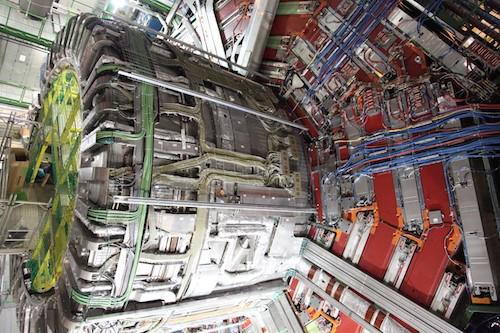The Higgs boson has been spotted bottoming out — but that’s a good thing. Physicists have detected the elementary particle decaying into two bottom quarks, exotic, short-lived particles that often appear in the aftermath of high-energy particle collisions. The elusive process was finally observed six years after the Higgs boson’s initial discovery, by physicists working at the Large Hadron Collider at CERN in Geneva. Researchers from two LHC experiments, ATLAS and CMS, reported their results simultaneously in a seminar held at CERN on August 28. (Courtesy ScienceNews)
The Higgs Particle and Top Quarks Connect
Direct coupling of the Higgs boson to the top quark observed
Today the CMS experiment at the Large Hadron Collider (LHC) of CERN published an observation in Physical Review Letters that connects for the first time the two heaviest elementary particles of the Standard Model. Members of the Department of Physics and Astronomy at the University of Tennessee contributed to this milestone.
Below: View of the CMS solenoid magnet, the central element of the CMS apparatus, during the 2013 shutdown. (Photo: CERN / CMS, Michael Hoch)

On July 4, 2012, two of the experiments at the CERN’s Large Hadron Collider, ATLAS and CMS, reported independently the discovery of the Higgs boson. The announcement created headlines worldwide: the discovery confirmed the existence of the last missing elementary particle of the Standard Model, half a century after the Higgs boson was predicted theoretically. At the same time the discovery marked also the beginning of an experimental program aimed to determine the properties of the newly discovered particle. Reporting today in Physical Review Letters, the CMS collaboration announces a milestone in that program.
In the Standard Model, the Higgs boson can couple to fermions, with a coupling strength proportional to the fermion mass. While associated decay processes have been observed, the decay into top quarks—the heaviest known fermion—is kinematically impossible. Therefore, alternative routes to directly probing the coupling of the Higgs boson to the top quark are needed. One is through the production of a Higgs boson and a top quark–antiquark pair (see the figure below). This is the production mechanism that has now been observed for the first time, and in doing so, the CMS collaboration accomplished one of the primary objectives of the Higgs physics program.

Diagrams of the coupling of the Higgs boson to the top quark. The production of a Higgs boson occurs in the fusion of a top quark–antiquark pair (left) or through emission from a top quark (right).
"The observation of the coupling between the two heaviest elementary particles of the Standard Model is a major step for the LHC physics program," said UT Physics Professor Stefan Spanier. "In the coming years, much more data will be collected and the precision will be improved in order to see if the Higgs behaves unexpectedly revealing the presence of physics beyond the Standard Model." Spanier’s high-energy physics research group operates a sub-detector of the CMS experiment with a postdoctoral researcher (Dr. Andres Delannoy) at CERN, and two graduate students, Himal Acharya and Adrian Cross, who support the data taking and analyze data from proton-proton collisions at the LHC.

Stefan Spanier (professor), Andres Delannoy (postdoc), Himal Acharya (graduate student) and Adrian Cross (graduate student).
Further information can be found at http://cms.cern/news/tth-announcement issued by CERN today, on the occasion of the opening of the LHCP2018 conference in Bologna (Italy), where the ATLAS collaboration is also presenting their latest results for the first time.

Signature of a candidate event in the CMS detector. Jet refers to a bundle of particle tracks. The red and blue bars correspond to energy deposits in the detector.
[1] CMS ttH observation journal article: http://cms-results.web.cern.ch/cms-results/public-results/publications/HIG-17-035/index.html
[2] June 2018 CERN Courier article: http://cerncourier.com/cws/article/cern/71524